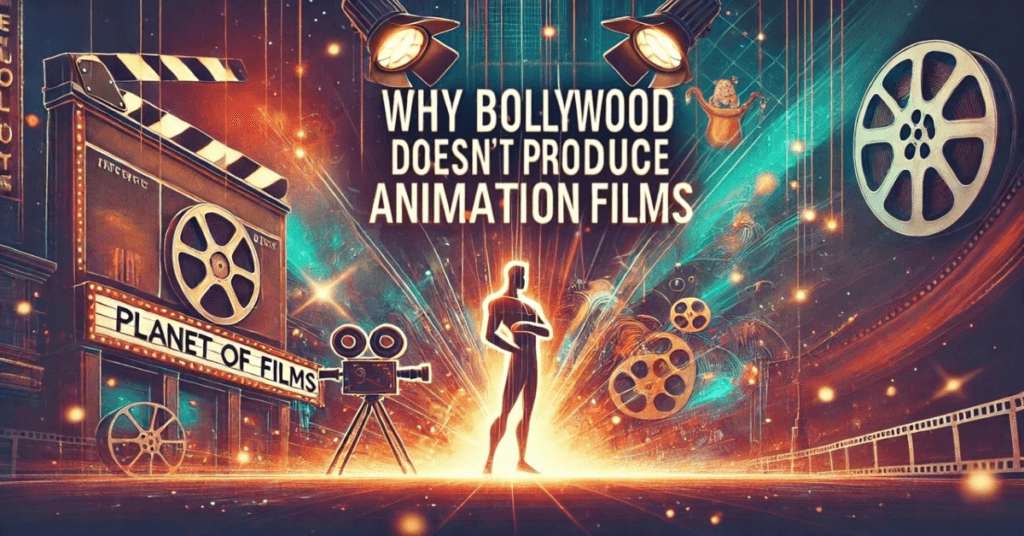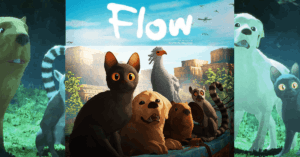Let’s be honest, when was the last time you heard about a Bollywood animated film that truly made waves? Exactly. Bollywood, the land of larger-than-life heroes, dramatic plot twists, and over-the-top song sequences, has never really embraced animation the way Hollywood or even some regional industries have. Sure, we’ve had a few brave (or misguided) attempts—Hanuman, Roadside Romeo, Arjun: The Warrior Prince—but none of them triggered a grand animation revolution. So, what’s stopping Bollywood from diving into the magical world of animation films?
Bollywood’s Fear of Animation films

Bollywood’s reluctance to invest in animation isn’t just about money, it’s about the industry’s deep-rooted obsession with faces. Big, bankable, starry faces. The formula is simple: slap Shah Rukh Khan’s or Salman Khan’s name on a poster, and boom, instant audience. But animation? No physical presence of superstars? Oh no, that’s too much of a gamble!
Here’s the kicker: Indian audiences already lap up animated films—just not homegrown ones. Hollywood’s animated features regularly perform well in India, proving that there’s a massive market. Take Flow and Mufasa: The Lion King, both of which saw a strong response. Even Flow, a relatively niche film, resonated with Indian viewers. The problem isn’t the audience—it’s Bollywood’s commitment issues with animation.
“Animation Is for Kids” (Says Who?)
Another roadblock is Bollywood’s outdated belief that animation is strictly a kiddie affair. Hollywood figured out ages ago that animated films can cater to everyone—case in point: Shrek, Inside Out, and Spider-Man: Into the Spider-Verse. Meanwhile, Bollywood still treats animation like that weird cousin nobody wants to invite to the wedding.
And let’s not forget the global gems that prove animation’s versatility. The French masterpiece I Lost My Body (2019) dives into existentialism, while China’s Ne Zha mixes mythology with breath-taking animation, smashing box office records. Meanwhile, Japan’s Grave of the Fireflies remains one of the most haunting war films ever made, animated or otherwise. But in Bollywood? The moment an animated film is announced, it’s automatically shoved into the “kids’ section.”
The truth is, audiences don’t mind mature animated films, it’s the filmmakers and distributors who lack the vision to break free from this age-old misconception.
Bollywood’s Dependence on Star Power
Bollywood is like that clingy ex who refuses to let go—except in this case, the attachment is to star power. If there isn’t a known face to plaster on a poster, filmmakers panic. A Salman Khan or Ranbir Kapoor movie guarantees a packed house, no matter the plot. But an animated film? Gasp! Who would even come to watch it?
Hollywood, of course, plays it smart by using A-list actors as voice talent. In India, the rare attempt at this like Saif Ali Khan and Kareena Kapoor voicing Roadside Romeo—didn’t exactly set the box office on fire. Turns out, audiences want to see their favourite stars, not just hear them.
Lack of Technical Expertise (And the Patience to Develop It)
Animation isn’t just another filmmaking technique, it’s an entirely different beast. Hollywood has decades of experience, while Bollywood is still figuring out how to make VFX look convincing in live-action films (cough Ra.One cough).
Yes, India has a strong VFX industry, but animating an entire feature film at Hollywood standards? That’s a different ball game. Skilled animators in India often move to gaming, VFX, or international projects because Bollywood simply doesn’t offer them the creative playground they need. When Bollywood does attempt animation, it’s usually subpar, making it hard for audiences to take it seriously.
The Myth That Animation films Can’t Make Money (Spoiler: It Can)
 Ah, the classic argument—“animation isn’t profitable.” Tell that to Disney, Pixar, or even China’s Ne Zha, which did wonders at the box office, proving that animated films, when made with conviction, can be just as profitable as live-action blockbusters.
Ah, the classic argument—“animation isn’t profitable.” Tell that to Disney, Pixar, or even China’s Ne Zha, which did wonders at the box office, proving that animated films, when made with conviction, can be just as profitable as live-action blockbusters.
Hollywood’s animation industry thrives not just on ticket sales but also on merchandise. The Toy Story franchise, for example, isn’t just about Woody and Buzz Lightyear’s adventures—it’s a marketing goldmine. Similarly, Frozen didn’t just conquer the box office; the real jackpot came from Elsa dolls, backpacks, and theme park attractions.
India, however, has a merchandise problem. Films like Baahubali and Krrish dabbled in action figures, but let’s be real—nobody is lining up to buy Bollywood character collectibles. Without merchandising as a safety net, Bollywood sees animation as a financial black hole.
Regional Cinema and Animation: A Glimmer of Hope?
If you thought regional cinema was boldly venturing into animation while Bollywood lagged behind, think again. Tamil cinema’s Kochadaiiyaan dabbled in motion-capture animation, and the Malayalam industry has put out a handful of animated mythological films. But let’s be real—none of these were game-changers. They were more like half-hearted experiments rather than a full-fledged push for animation.
The hard truth? Even regional industries aren’t exactly taking massive risks in animation. They’re still testing the waters cautiously, and most attempts either stick to mythology (because, well, that’s the safest bet) or remain niche projects that don’t get the spotlight they deserve.
So, if Bollywood ever decides to break its animation dry spell, it needs to stop waiting for a “perfect moment” and just go for it. Instead of betting big on a full-fledged animated feature, why not start with live-action hybrids, animated segments within films, or even indie animated projects with fresh storytelling? Something—anything—that doesn’t just feel like an afterthought.
Can Bollywood Ever Have Its Own Pixar? (Hope Springs Eternal)
Technically, yes. India has the talent, the tech, and a massive audience. What’s missing? The guts to take animation seriously.
Imagine an animated Bollywood musical with jaw-dropping visuals, gripping storytelling, and universal appeal. Think Coco (2017) but deeply rooted in Indian culture. Or a high-octane action film in the style of Spider-Man: Across the Spider-Verse (2023), but set in an Indian metropolis. If done right, these could redefine Bollywood animation.
Final Thoughts
Bollywood’s refusal to embrace animation isn’t about lack of potential—it’s about old-school thinking, technical hesitation, and an over-reliance on big-name stars. As Indian audiences get more exposure to high-quality international animation, the demand for homegrown animated content might finally push Bollywood to take the leap. Who knows? Maybe one day, we’ll get an Indian animated film that’s more than just a half-hearted attempt to cash in on mythology. But until then, we’ll just have to keep watching Toy Story re-runs and wondering what could have been.
Read More:



























